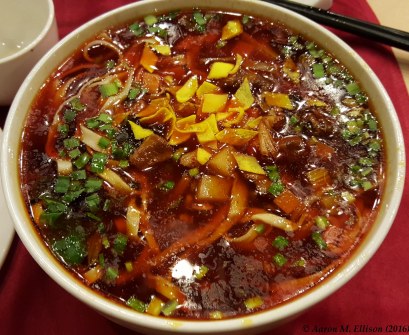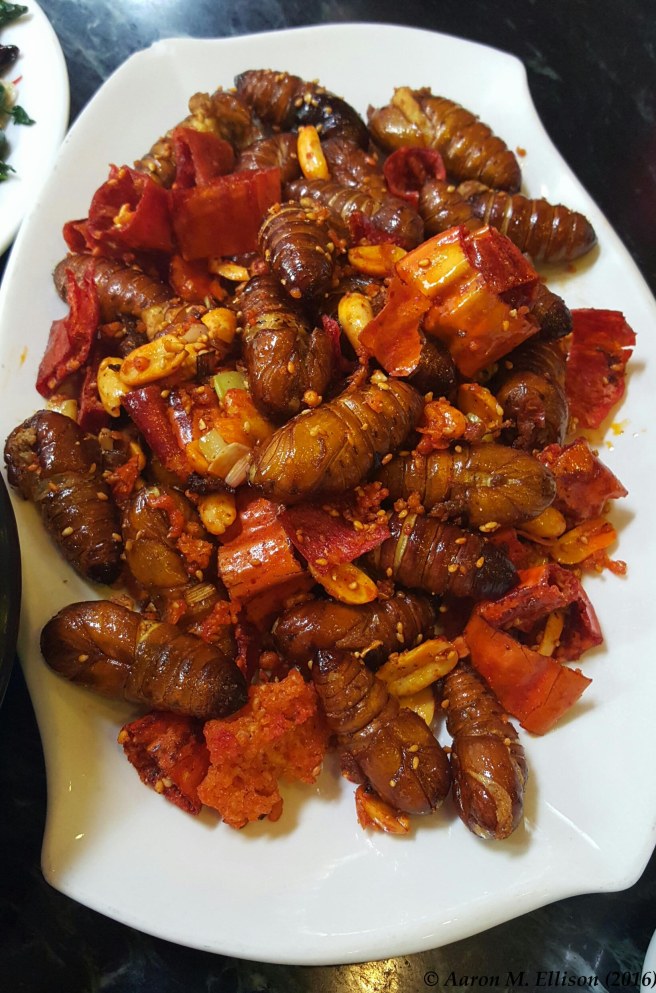On August 21, 2016, I flew from Singapore to Xi’an, China, to begin a two-month research, teaching, and travel fellowship awarded by the Chinese Academy of Sciences. This exciting opportunity is allowing me to visit and work with colleagues and their students at the Institute of Earth Environment in Xi’an, the Institute for Tibetan Plateau Research in Beijing, the Research Center for Eco-Environmental Sciences in Beijing, and the Computational and Medical Ecology Laboratory in Kunming.
It’s also providing an incredible opportunity to eat!
Within literally minutes of arriving at my hotel just inside the 2nd ring road around  downtown Xi’an, my sponsor, Professor Chen Yi-ping (left), one of his Ph.D. students, Chen Dong, and I decamped to the hotel dining room where we started the week’s culinary excursion.
downtown Xi’an, my sponsor, Professor Chen Yi-ping (left), one of his Ph.D. students, Chen Dong, and I decamped to the hotel dining room where we started the week’s culinary excursion.
Most of the dinners this week focused on a particular region’s cuisine and included multiple courses, but this first night I only managed a picture of one of the five dishes, Qishan noodles, so-named for the county of Qishan in the province of Shaanxi, where Xi’an is also located.

Qishan noodles are delicious and, of course, very spicy!
The second day, Chen Dong asked if I wanted to go to the hotel again for dinner, but I suggested we try something local on the way, rather than sticking to hotel food. This idea brightened everyone up, and we set off for the Lushan Hand-pulled beef noodle shop. This was another excellent meal and we were able to watch the cooks pulling noodles and dishing out bowls of steaming soup while we watched. The orange soda was a nice touch, especially given the hot temperatures (over 38 C or 100 F since I arrived)

By Day 3 (Wednesday), I’d started to figure out the routine. This evening the centerpieces of the dinner were local jiaozi (a Xi’an variety of dumplings), but for me the highlight was the Guangzhou-style silkworm (Bombyx mori) pupae gently sauteed with mildly hot red peppers and peanuts! The pupae had a nice crunchy outside and were creamy and nut-flavored on the inside. Not something we’re likely to see in the US anytime soon, I suspect.
Thursday evening, post-doc Liu Wan-gang (a Xi’an city native) and I headed for the central part of the city, inside the Tang Dynasty city walls (more on that later this week). Because of its role as the first capital city and its nexus on the Silk Road, Xi’an has a variety of ethnic groups and cuisines that have melded over many centuries. Nowhere is this more apparent than on the Muslim Road that goes right through the center of the old city (click on either image for a larger view).
It felt like the entire city (and all the tourists from throughout China and elsewhere in the world) were all on this street at the same time, foraging for dinner. Wan-gang and I grazed from one end of the road to the other as he guided me to his favorite shops and stalls for particular delicacies (click on individual photos below for larger versions)
We started with a most memorable dish of fried tofu-skin, beef stomach, sesame paste, and chili. This was followed a block later by sauteed mung-bean jelly, which we had with noodles, a thin lassi-style yogurt, and plum juice. Next, we had “starch soup”, which is the Xi’an version of Belizean boil-up: stock thickened with rice flour, to which is added whatever is at hand, such as cabbage, potatoes, meat balls, and of course, chili sauce. After an interlude for a sweet cake (flavored with something resembling rose-water), we finished with a barbecued beef-satay. We entered this restaurant through an alleyway barely wide enough for me to squeeze. Although I thought ordering 30 skewers might be excessive, they disappeared quite readily!
By Friday, I was starting to worry about my waistline, but the meals did not let up! Ph.D. student Su Cui-cui took me out that night for crayfish and beer. After starting with an appetizer of edamame and peanuts (the contrast is quite nice compared to the straight-up edamame served in Japan), we had two platters of crayfish: one spicy, the other with garlic. The latter probably had more garlic than crayfish! (click on the photos for larger versions)
But at least Monday through Friday I had only the dinners to content with, lunches having been served at the cafeteria in the institute. But Saturday, my visit with Cui-cui to the Terra Cotta Warrior museum (more on that another day) featured both lunch and dinner!
Lunch was several different kinds of dumplings (I’ll have to remember to take photos of dumplings next time), and dinner was a Cheng-du (Szechuan-style) repast. We started with pork sausage with peanuts, a stir-fry on sweet rice cakes, stir-fried cabbage, and chicken rolled in sesasme seeds and sauteed with medium-hot red peppers. And hot-and-sour soup! Of the entire week’s meals, this one was the most familiar, as we have plenty of Szechuan restaurants in the US. The variety of dishes here, though, far exceeds what I’ve seen anywhere stateside. (click on the photos for larger versions)
Sunday wrapped up the week. Two other Ph.D. students, Yan and Juen, spent the day with me at the Shaanxi History Museum, the Shaanxi Museum of Art, and the Wild Goose Pagoda. In between the museums, we went for lunch – Hunan-style hot-pot – which was a real highlight for the week.
The hot-pot is divided in two parts – spicy on the left (ours had fish with lime and hot green peppers) and a mild broth on the right. It sits nicely in the middle of the table on a heating element, which was brought to a rolling boil.

Once it’s nicely boiling, other ingredients, selected a la carte, are added at will. We had mushrooms, tofu three ways, and vegetables from the salad bar. The variety of mushrooms was truly exquisite, but more interesting things showed up in the other two.

The three types of tofu were familiar (right), a little unfamiliar (left), and mixed with duck’s blood (center). The last had a texture somewhat like a duck pudding and a taste in between chocolate and tofu!

But far and away the most interesting was the variety of vegetables. From Indian lettuce (Lactuca indica), potatoes, corn and pumpkin, we moved on to more mushrooms, seaweed, and konjac (the light-tan/speckled jelly towards the back of the bowl)
 Konjac is made from the root of the aroid Amorphophallus konjac, whose relative, the Titan Arum is always in the news when it flowers. Not only had I no idea it could be eaten, but a look-up on Wikipedia (click here) reveals the myriad of uses it has. It’s probably part of many food products that I’ve eaten in my lifetime. This lunch was so huge, I had to gently apologize and skip dinner!
Konjac is made from the root of the aroid Amorphophallus konjac, whose relative, the Titan Arum is always in the news when it flowers. Not only had I no idea it could be eaten, but a look-up on Wikipedia (click here) reveals the myriad of uses it has. It’s probably part of many food products that I’ve eaten in my lifetime. This lunch was so huge, I had to gently apologize and skip dinner!

















1) thank you for sending this – much easier to see and enjoy on a large screen
2) Amazingly, A. konjac has been growing for years in my garden under its synonym A. rivereii. or the hydrosome. Thus said, you can now try a few of the 20+ other amorphophallae to see which one works, so you can start your own Chinese restaurant Aaron’s and Flossie’s Xian Mecca in Petersham or Cambridge but not Royalston – population too small to support it.
LikeLike
What a great idea, thanks! Of course Petersham is not really any larger than Royalston, though, and running a restaurant would leave far too little time for travel.
LikeLike
worm !!! 😦
LikeLike